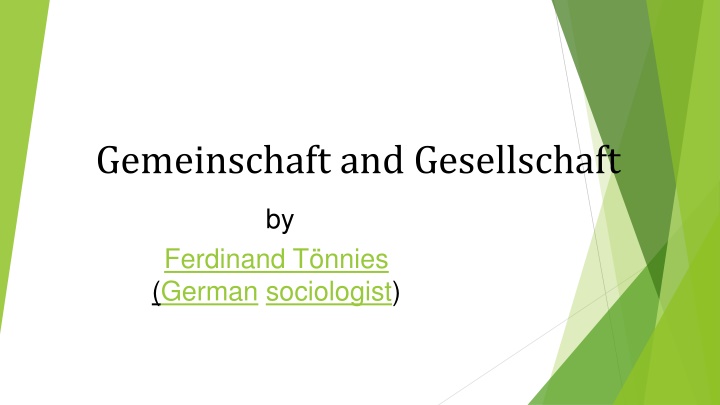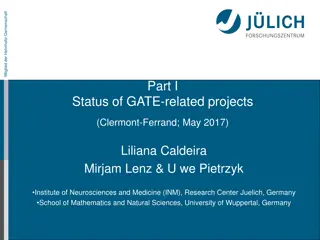
Gemeinschaft and Gesellschaft Societal Dichotomy
Explore Ferdinand Tönnies' concept of Gemeinschaft (community) and Gesellschaft (society), analyzing the dichotomy in social interactions and values. Compare with Max Weber and Emile Durkheim's perspectives on societal solidarity and organization. Delve into the transition from traditional to modern societies based on Tönnies' works.
Uploaded on | 0 Views
Download Presentation

Please find below an Image/Link to download the presentation.
The content on the website is provided AS IS for your information and personal use only. It may not be sold, licensed, or shared on other websites without obtaining consent from the author. If you encounter any issues during the download, it is possible that the publisher has removed the file from their server.
You are allowed to download the files provided on this website for personal or commercial use, subject to the condition that they are used lawfully. All files are the property of their respective owners.
The content on the website is provided AS IS for your information and personal use only. It may not be sold, licensed, or shared on other websites without obtaining consent from the author.
E N D
Presentation Transcript
Gemeinschaft and Gesellschaft by Ferdinand T nnies (German sociologist)
According to the dichotomy, social ties can be categorized, on one hand, as belonging to personal social interactions, and the roles, values, and beliefs based on such interactions (Gemeinschaft) German, commonly translated as community"), or on the other hand as belonging to indirect interactions, impersonal roles, formal values, and beliefs based on such interactions (Gesellschaft, commonly translated as society"). German,
The first edition was published in 1887 with the subtitle "Treatise on Communism and Socialism as Empirical Patterns of Culture The second edition, published in 1912, of the work in which T nnies further promoted the concepts
The concepts Gemeinschaft and Gesellschaft were also used by Max Weber in Economy and Society, which was first published in 1921. Weber wrote in direct response to T nnies, and argued that Gemeinschaft is rooted in a "subjective feeling" that may be "affectual or traditional". Gesellschaft-based relationships, according to Weber, are rooted in "rational agreement by mutual consent", the best example of which is a commercial contract.
In a review of Tnnies' book in 1889, Durkheim interpreted Gemeinschaft as an organic community, and Gesellschaft as a mechanical one, reproaching T nnies for considering the second organisation artificial, and not seeing the transition from the one type to the other. type of social
Emile Durkheims Mechanical and Organic Solidarity In a society showing exhibiting mechanical solidarity, its cohesion and integration comes from the homogeneity of individuals people feel connected through similar work, educational and religious training, and lifestyle. Mechanical solidarity normally operates in "traditional" and small-scale societies. In simpler societies (e.g. Tribal ), solidarity is usually based on kinship ties of familial networks. Organic solidarity comes from the interdependence that arises from specialization of work and the complementarities between people a development which occurs in modern and industrial societies. It is social cohesion based upon the dependence individuals have on each other in more advanced societies. Although individuals perform different tasks and often have different values and interests, the order and very solidarity of society depends on their reliance on each other to perform their specified tasks. Thus, social solidarity is maintained in more complex societies through the interdependence of its component parts (e.g., farmers produce the food to feed the factory workers who produce the tractors that allow the farmer to produce the food).


















